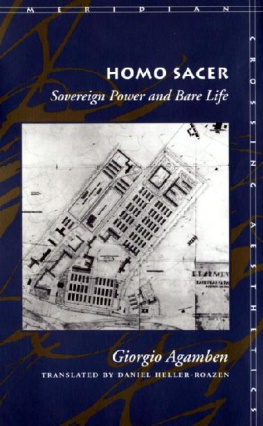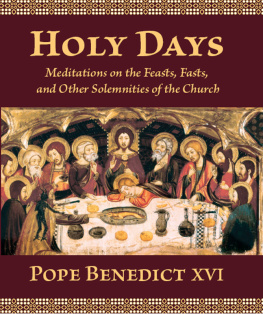MERIDIAN
Crossing Aesthetics
Werner Hamacher
Editor
THE MYSTERY OF EVIL
Benedict XVI and the End of Days
Giorgio Agamben
Translated by Adam Kotsko
STANFORD UNIVERSITY PRESS
STANFORD, CALIFORNIA
Stanford University Press
Stanford, California
English translation 2017 by the Board of Trustees of the Leland Stanford Junior University. All rights reserved.
The Mystery of Evil was originally published in Italian in 2013 under the title Il mistero del male: Benedetto XVI e la fine dei tempi 2013 by Giorgio Agamben. Originally published by Gius. Laterza & Figli, S.p.A. Roma-Bari. This book was negotiated through Agnese Incisa Agenzia Letteraria, Torino.
Translators Note 2017 by the Board of Trustees of the Leland Stanford Junior University. All rights reserved.
No part of this book may be reproduced or transmitted in any form or by any means, electronic or mechanical, including photocopying and recording, or in any information storage or retrieval system without the prior written permission of Stanford University Press.
Printed in the United States of America on acid-free, archival-quality paper
Library of Congress Cataloging-in-Publication Data
Names: Agamben, Giorgio, 1942 author.
Title: The mystery of evil : Benedict XVI and the end of days / Giorgio Agamben ; [translated by] Adam Kotsko.
Other titles: Mistero del male. English | Meridian (Stanford, Calif.)
Description: Stanford, California : Stanford University Press, 2017. | Series: Meridian: crossing aesthetics | Originally published in Italian in 2013 under the title Il mistero del male. Benedetto XVI e la fine dei tempi. | Includes bibliographical references.
Identifiers: LCCN 2016049164 (print) | LCCN 2016050729 (ebook) | ISBN 9781503600935 (cloth : alk. paper) | ISBN 9781503602731 (pbk. : alk. paper) | ISBN 9781503602748 (ebook) | Subjects: LCSH: Benedict XVI, Pope, 1927Abdication, 2013. | Political theology. | Good and evil. | Eschatology.
Classification: LCC BX1378.6 .A3313 2017 (print) | LCC BX1378.6 (ebook) | DDC 282.092dc23
LC record available at https://lccn.loc.gov/2016049164
Contents
Translators Note
For this text, I have broken with a long-established tradition in Agamben translations by declining to mark the distinction between two pairs of terms: diritto/legge and potere/potenza (conventionally translated as juridical order/law and power/potential, respectively). In neither of these texts is Agamben exploring the conceptual problems that motivated the technical usage of these pairs, and hence translating them in the conventional way struck me as unidiomatic and distracting. Nevertheless, Agambens usage of the respective pairs is systematic within this text and can be tracked fairly easily based on the sense. Diritto appears exclusively in The Mystery of the Church and always refers to law in general (for instance, diritto naturale e diritto positivo is translated as natural law and positive law rather than natural juridical order and positive juridical order), and every use of law in the context of the exposition of the biblical text corresponds to legge; potere refers to political power in an abstract sense (e.g., constitutional powers or state powers), while potenza refers to concrete political powers in the sense of visible institutions (the Roman Empire, the Catholic Church, etc.). The only exception to the latter rule comes in Agambens rendering of 2 Thessalonians 2:9, where Satan is said to use all power (ogni potenza).
For Greek terms, I have supplied macrons, which do not appear in Agambens Italian text. The lack of macrons sometimes creates ambiguity as to whether we are dealing with the katechn (the personal form: the one who restrains) or the katechon (the impersonal form: what restrains), and I have opted to add or omit the macron depending on what seemed to me to be the more likely sense in any given case. Finally, I regret that there was no possible translation for the subtitle of the second essay that did not introduce a rhyme that does not exist in the Italian.
I would like to thank Carlo Salzani for checking my translation against the Italian text and to extend my continued gratitude to Emily-Jane Cohen and the entire staff of Stanford University Press.
Prefatory Note
Mysterium iniquitatis represents the unpublished text of a lecture delivered at Freiberg, Switzerland, on November 13, 2012, on the occasion of an awarding of an honorary doctorate in theology. The arguments treated on that occasion are so tightly interconnected with the following attempt at an interpretation of Benedict XVIs abdication (The Mystery of the Church) that I did not believe it necessary to conceal the proximity by mitigating assonances and repetitions. Both texts in fact think one single problem: that of the political meaning of the messianic theme of the end of days, today as much as twenty centuries ago.
I. The Mystery of the Church
In these pages I will seek to understand Pope Benedict XVIs decision by situating it in the theological and ecclesiastical context proper to it. And yet I will consider this decision in its exemplarity, which is to say, because of the consequences that it is possible to draw from it for an analysis of the political situation of the democracies in which we live.
Indeed, I am convinced that in carrying out the great refusal, Benedict XVI has given proof not of cowardiceas, according to an exegetical tradition that is far from reliable, Dante wrote of Celestine Vbut of a courage that today takes on an exemplary sense and value. The reasons invoked by the pontiff to justify his decision, certainly true in part, cannot in any way account for a gesture that has an entirely unique meaning in the history of Church. And this gesture acquires its full weight if one remembers that on April 28, 2009, Benedict XVI had laid down, precisely on the tomb of Celestine V in Sulmona, the pallium that he had received at the moment of his investiture, proving that the decision had been thoroughly considered beforehand. Celestine V had justified his abdication with almost the same words as Benedict XVI, speaking of weakness of body (debilitas corporis; Benedict XVI invoked a diminution of strength of body, vigor corporis) and of personal infirmity (infirmitas personae); but already the early sources inform us that the true reason was to be sought in his indignation at the barratries and simonies of the court.
Why does this decision appear so exemplary to us today? Because it forcefully calls attention to the distinction between two essential principles of our ethico-political tradition, of which our societies seem to have lost all awareness: legitimacy and legality. If the crisis that our society is going through is so profound and serious, it is because it does not call into question only the legality of institutions, but also their legitimacy; not only, as is repeated too often, the rules and modalities of the exercise of power, but the very principle that founds and legitimates it.
Powers and institutions are not delegitimated today because they have fallen into illegality; rather the contrary is true, namely that illegality is so diffuse and generalized because the powers have lost all awareness of their legitimacy. For this reason it is futile to believe that we can confront the crisis of our societies through the actionwhich is certainly necessaryof the judiciary power: a crisis that affects legitimacy cannot be resolved solely on the level of law. The hypertrophy of law, which presumes to legislate over everything, on the contrary betrays, through an excess of formal legality, the loss of all substantial legitimacy. Modernitys attempt to make legality and legitimacy coincide, by seeking to secure through positive law the legitimacy of a power, is completely inadequate, as is clear from the inexorable process of decline into which our democratic institutions have entered. A societys institutions remain living only if both principles (which in our tradition have also received the name of natural law and positive law, spiritual power and temporal power, or in Rome,
Next page










